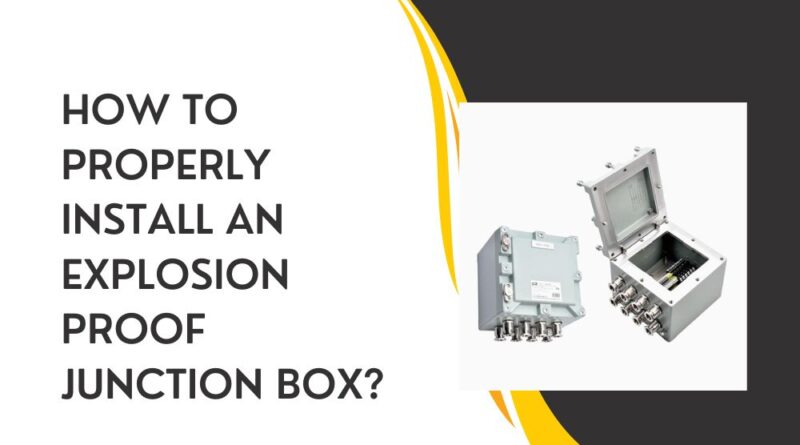How to Properly Install an Explosion Proof Junction Box?
Installing an explosion-proof junction box is essential in businesses where safety and accuracy are crucial, such as chemical factories, oil rigs, or any setting with potentially dangerous, explosive gasses or particles. In order to ensure safety and compliance, this guide will lead you through the necessary processes and considerations for installing an explosion proof junction box correctly.
Understanding Explosion-Proof Junction Boxes
What Is an Explosion-Proof Junction Box?
An explosion-proof junction box is designed to contain any explosion originating within its housing and prevent sparks from igniting vapors, gases, dust, or fibers in the surrounding air. This is crucial in hazardous environments to prevent fires and explosions.
Importance of Correct Installation
Proper installation is not just about following regulations; it’s about ensuring the safety of the facility and everyone inside. An incorrectly installed junction box could fail to contain a spark or explosion, leading to potentially disastrous consequences.
Pre-Installation Planning
Assessing the Environment
- Identify Hazardous Zones: Understand the specific classification of the hazardous areas where the junction box will be installed. This will determine the type of explosion-proof junction box needed.
- Review Regulations and Standards: Check local and international standards, such as ATEX or NEC, that apply to your installation to ensure compliance.
Gathering the Right Tools and Equipment
- Specialized Tools: Ensure you have tools that are suitable for use in hazardous environments, which might include non-sparking tools or insulated tools.
- Appropriate Sealing Materials: Obtain the correct type of sealing fittings designed for explosion-proof installations to maintain the integrity of the junction box.
Installation Process
Mounting the Junction Box
- Choose the Right Location: The box should be easily accessible for maintenance but far enough from any potential sources of damage or excessive heat.
- Securely Mount the Box: Use mounting brackets and hardware suitable for the environment (e.g., corrosion-resistant materials in damp locations).
Wiring the Junction Box
- Use Suitable Wiring Methods: Ensure that all wiring complies with safety standards for hazardous areas. Wires should be properly insulated, and the correct type of cable glands (explosion-proof) should be used.
- Maintain Integrity of Seals: When inserting wires into the box, make sure that all entries are sealed properly to prevent gases and dust from entering.
Making Electrical Connections
- Follow Wiring Diagrams: Carefully follow the wiring diagrams provided with the junction box to avoid errors in connections.
- Secure Connections: Use the appropriate screwdrivers or wrenches to ensure that all connections are tight and secure.
Finalizing Installation
- Inspect Seals and Enclosures: Check all seals and enclosures to ensure they are intact and provide a secure environment inside the box.
- Grounding the Junction Box: Properly ground the junction box to prevent electrical shocks and reduce the risk of static charges that could ignite explosive materials.
Post-Installation Testing and Maintenance

Conducting Initial Testing
- Check for Compliance: Test the installation to ensure it meets all regulatory requirements and functions as expected in its environment.
- Functional Testing: Turn on the power and test the functionality of the installed electrical components to ensure they are working correctly.
Regular Maintenance and Inspections
- Scheduled Inspections: Regularly inspect the junction box and its connections for signs of wear or damage. Replace any defective parts immediately.
- Maintain Cleanliness: Keep the junction box clean from dust and debris, which could accumulate and potentially ignite.
Safety Precautions
Always Follow Safety Protocols
- Wear Protective Gear: Always wear the appropriate safety gear, including gloves, goggles, and other protective equipment, when installing or maintaining the junction box.
Stay Informed
- Continuous Education: Stay updated on the latest safety practices and installation techniques for explosion-proof junction boxes.
- Consult Experts: If unsure about any aspect of the installation, consult with a certified electrician or engineer who specializes in hazardous area equipment.
Conclusion
Proper installation of an explosion-proof junction box is crucial for maintaining safety in hazardous environments. By meticulously planning, using the right tools and materials, and adhering to detailed installation and maintenance procedures, you can ensure that these critical components function effectively to mitigate risks. Remember, safety is paramount, and every step taken with precision contributes to a safer working environment.
Note:- For more articles visit on nichenest.




